
Pest is the eastern, mostly flat part of Budapest, Hungary, comprising about two thirds of the city's territory. It is separated from Buda and Óbuda, the western parts of Budapest, by the Danube River. Among its most notable sights are the Inner City, the Hungarian Parliament, Heroes' Square and Andrássy Avenue. In colloquial Hungarian, "Pest" is often used for the whole capital of Budapest. The three parts of Budapest united in 1873.

Count István Széchenyi de Sárvár-Felsővidék was a Hungarian politician, political theorist, and writer. Widely considered one of the greatest statesmen in his nation's history, within Hungary he is still known to many as "the Greatest Hungarian".

The Széchenyi Chain Bridge is a suspension bridge that spans the River Danube between Buda and Pest, the western and eastern sides of Budapest, the capital of Hungary. Designed by the English engineer William Tierney Clark and built by the Scottish engineer Adam Clark, it was the first permanent bridge across the Danube in Hungary. It was opened in 1849.
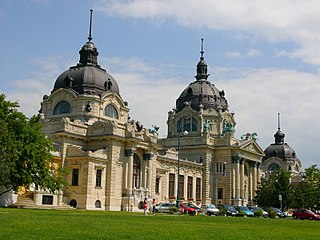
The City Park is a public park close to the centre of Budapest, Hungary. It is a 0.9-by-0.6-mile rectangle, with an area of 302 acres (1.2 km2), located in District XIV of Budapest. Its main entrance is at Heroes' Square, one of Hungary's World Heritage sites.

The National Széchényi Library (OSZK) is a library in Budapest, Hungary. It is one of two Hungarian national libraries, the other being University of Debrecen Library.

Batthyány Square is a town square in Budapest. It is located on the Buda side of the Danube directly opposite the Hungarian Parliament Building. It is named after Lajos Batthyány, the first Prime Minister of Hungary, and a statue for him was erected in 2008.
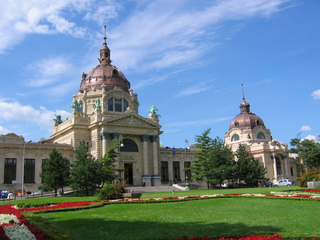
The Széchenyi Medicinal Bath in Budapest is the largest medicinal bath in Europe. Its water is supplied by two thermal springs, their temperature is 74 °C (165 °F) and 77 °C (171 °F).

The Gresham Palace (Gresham-palota) is a building in Budapest, Hungary; it is an example of Art Nouveau architecture. Completed in 1906 as an office and apartment building, it is today the Four Seasons Hotel Budapest Gresham Palace, a luxury hotel managed by Four Seasons Hotels. It is located along the River Danube, adjacent to Széchenyi Square and the eastern terminus of the Széchenyi Chain Bridge.

Central Hungary is one of the seven statistical regions in Hungary. It includes Budapest and Pest County.
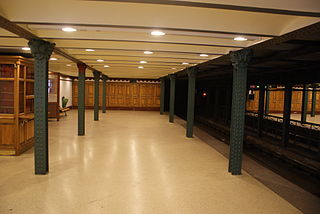
Hősök tere is a station of the yellow M1 line of the Budapest Metro under Hősök tere. It was formerly called Aréna út Station.

The Danube Promenade is located on the Pest side of Budapest, Hungary. On the bank of the Danube, this promenade extends from the Széchenyi Chain Bridge to the Erzsébet Bridge.
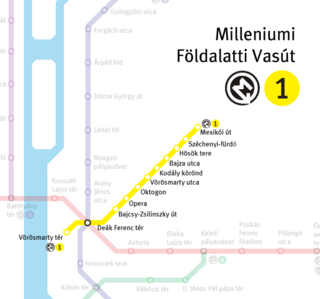
Line 1 is the oldest line of the Budapest Metro. It is known locally as "the underground", while the M2, M3 and M4 are called "metró". It is the third oldest underground after the London Underground and the Mersey Railway, the third rapid transit rail line worldwide of any type to exclusively use electric traction, and the first on the European mainland. It was built from 1894 to 1896.
Gábor Preisich was a Hungarian architect. He won the Herder Prize in 1975 along with Romanian poet Nichita Stănescu.

Count Gyula Széchényi de Sárvár-Felsővidék was a Hungarian politician, who served as Minister besides the King between 1900 and 1903. Széchényi was 70 years old when appointed by Kálmán Széll.

Count Ferenc Széchényi was the founder of the Hungarian National Library and National Museum in Budapest. The library is named after him the National Széchényi Library. He was the father of István Széchenyi.

Count Bertalan Széchényi de Sárvár-Felsővidék was a Hungarian politician, who served as Speaker of the House of Magnates from 1 May 1935 until his death.
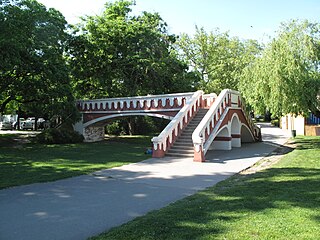
Állatkert was an above-ground station of the M1 line of the Budapest Metro. It existed between Széchenyi fürdő and Hősök tere from 1896 to 1973.


















